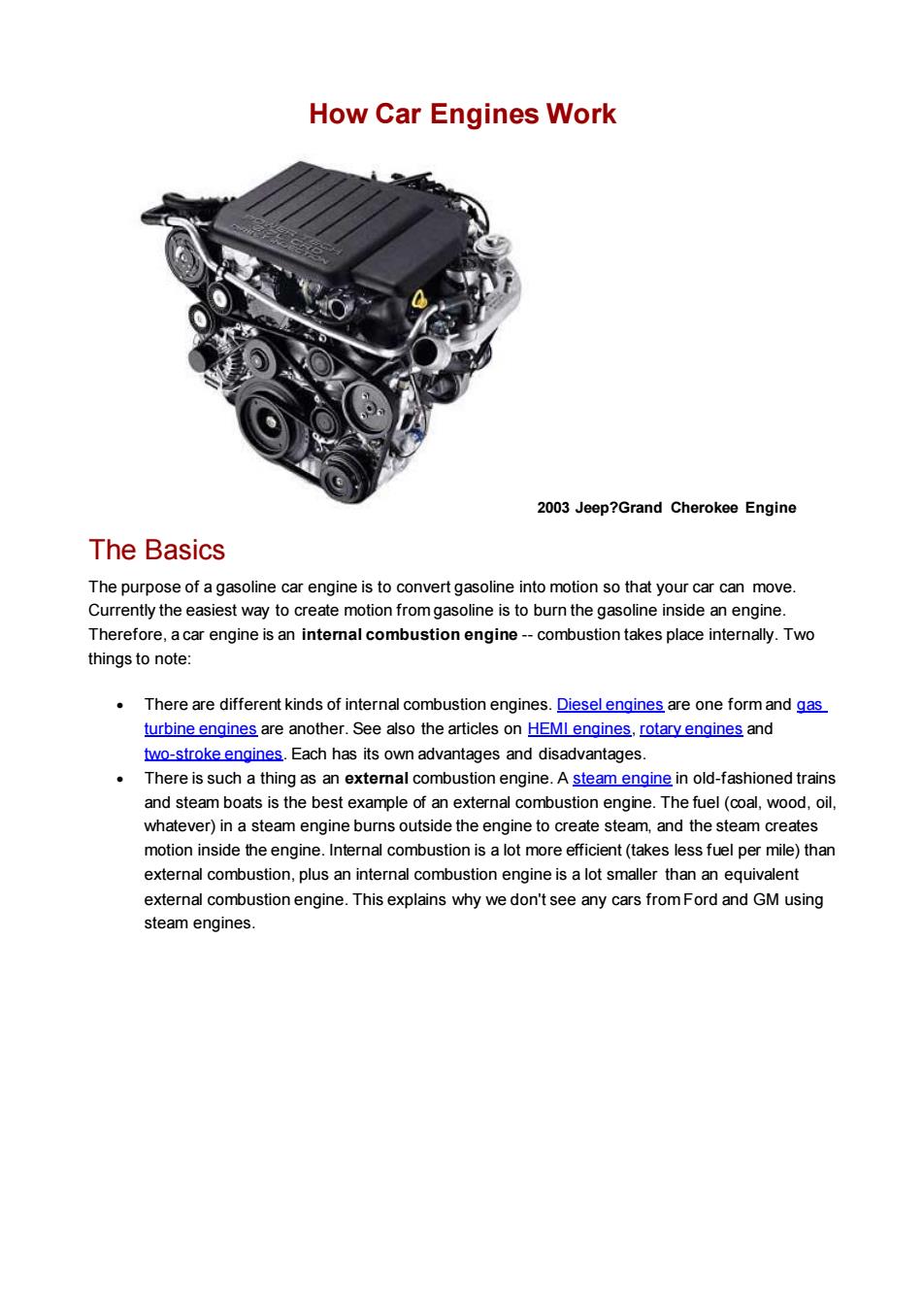
HowCarEnginesWork2003Jeep?GrandCherokeeEngineTheBasicsThepurposeof a gasoline car engine isto convertgasoline into motion so that your carcan move.CurrentlytheeasiestwaytocreatemotionfromgasolineistoburnthegasolineinsideanengineTherefore,a car engine is an internalcombustion engine --combustion takes place internally.Twothingsto noteTherearedifferentkindsof internal combustionengines.Dieselenginesareoneformandgasturbine engines areanother.See also the articles on HEMIengines,rotary engines andtwo-stroke enaines.Eachhas its own advantages and disadvantagesThere is such a thing as an external combustionengine.A steam engine in old-fashionedtrainsand steamboatsisthebestexampleof an external combustion engine.Thefuel (coal,wood,oil.whatever)in a steam engineburns outsidetheengineto create steam,and the steamcreatesmotion insidetheengine.Internalcombustionisalotmoreefficient(takeslessfuelpermile)thanexternal combustion,plusaninternal combustionengineisalotsmallerthananequivalentexternal combustion engine.This explains why wedon't see any cars fromFord and GM usingsteamengines
How Car Engines Work 2003 Jeep?Grand Cherokee Engine The Basics The purpose of a gasoline car engine is to convert gasoline into motion so that your car can move. Currently the easiest way to create motion from gasoline is to burn the gasoline inside an engine. Therefore, a car engine is an internal combustion engine - combustion takes place internally. Two things to note: • There are different kinds of internal combustion engines. Diesel engines are one form and gas turbine engines are another. See also the articles on HEMI engines, rotary engines and two-stroke engines. Each has its own advantages and disadvantages. • There is such a thing as an external combustion engine. A steam engine in old-fashioned trains and steam boats is the best example of an external combustion engine. The fuel (coal, wood, oil, whatever) in a steam engine burns outside the engine to create steam, and the steam creates motion inside the engine. Internal combustion is a lot more efficient (takes less fuel per mile) than external combustion, plus an internal combustion engine is a lot smaller than an equivalent external combustion engine. This explains why we don't see any cars from Ford and GM using steam engines
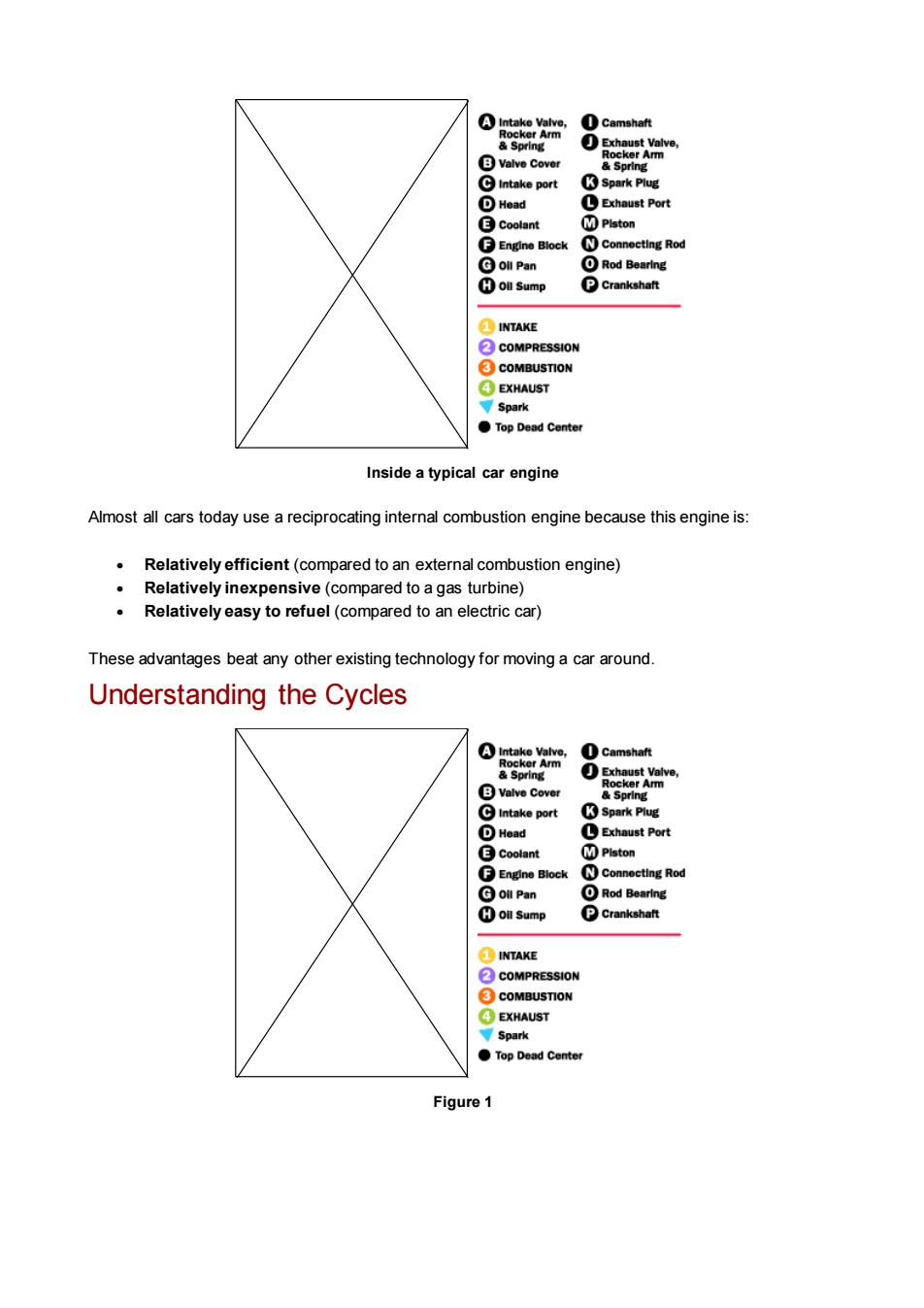
A IntakeValve,OCamshaftRockerArmOExhaust Valve,&SpringRockerAmBValve Cover&Springintake portKSpark PlugExhaust PortOHeadMPlistoncoolantEngine BlockConnectingRodORod BearingGoll Pancrankshaftoll SumpINTAKECOMPRESSION③COMBUSTION@EXHAUSTSparkTop Dead CenterInsideatypical carengineAlmost all cars today use a reciprocating internal combustion engine because this engine is:Relativelyefficient (comparedtoanexternalcombustionengine)-Relativelyinexpensive(comparedtoagasturbine)..Relativelyeasytorefuel (comparedtoanelectriccar)Theseadvantagesbeatanyotherexistingtechnologyformovingacararound.Understanding theCyclesAIntake Valve,OcamshaftRockerArmOExhaust Valve,&SpringRockerAmBValve Cover&SpringCIntake portSpark PlugOHeadExhaust PortMPistonECoolant@Connecting RodEngine BlockORod BearingGoll Panoil SumpPcrankshaftINTAKECOMPRESSIONCOMBUSTION4EXHAUSTSparkTopDead CenterFigure1
Inside a typical car engine Almost all cars today use a reciprocating internal combustion engine because this engine is: • Relatively efficient (compared to an external combustion engine) • Relatively inexpensive (compared to a gas turbine) • Relatively easy to refuel (compared to an electric car) These advantages beat any other existing technology for moving a car around. Understanding the Cycles Figure 1
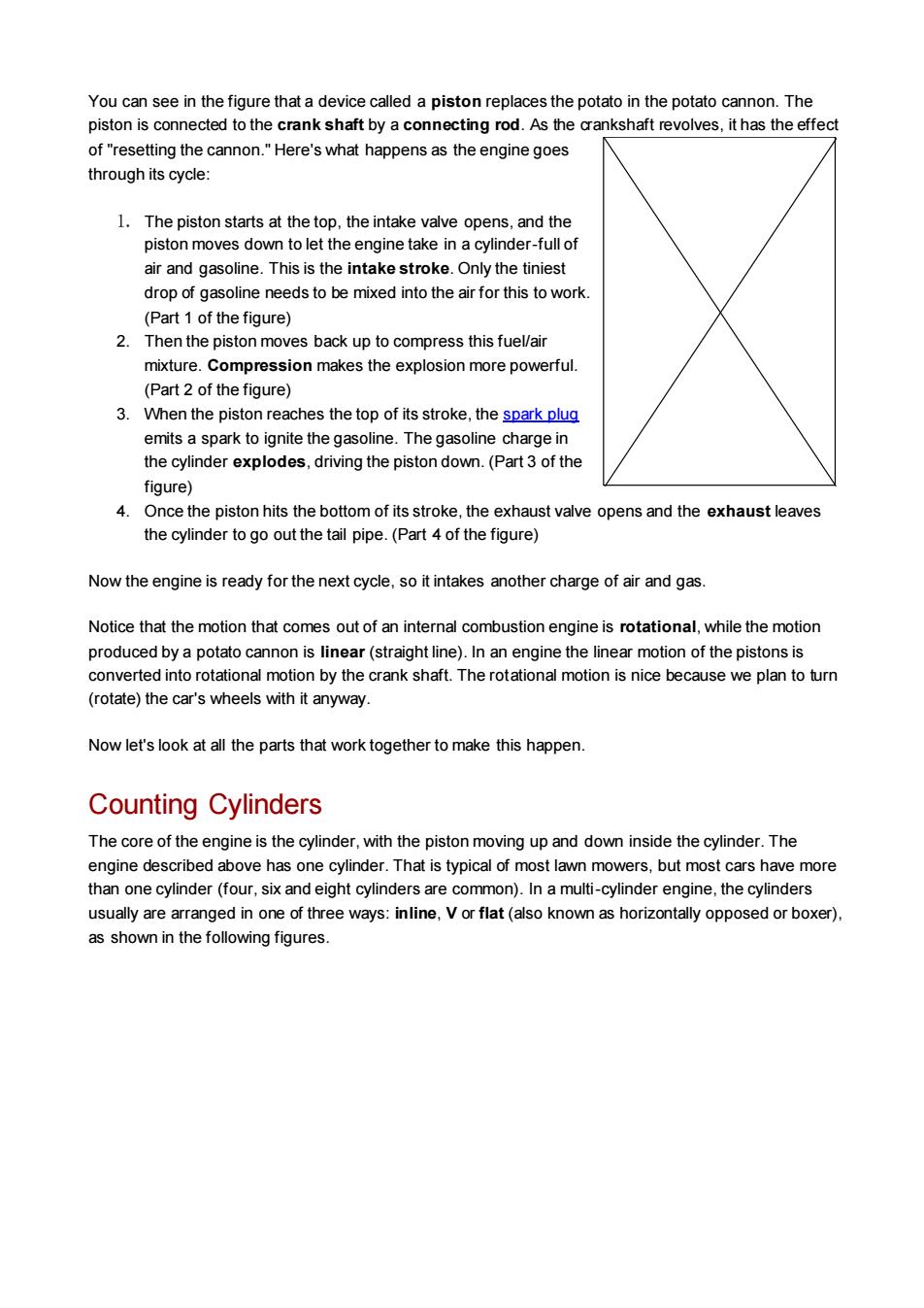
You can see inthefigurethata device called a pistonreplaces thepotato in thepotato cannon.Thepiston is connected to the crank shaft bya connecting rod.As the crankshaft revolves,it has theeffectof"resettingthecannon."Here'swhathappensastheenginegoesthrough its cycle:l.Thepistonstartsatthetop,theintakevalveopens,andthepiston moves down to let the engine take in a cylinder-full ofair and gasoline.This is the intakestroke.Onlythe tiniestdropofgasolineneedstobemixedintotheairforthistowork.(Part 1 of the figure)2.Thenthepistonmovesbackuptocompressthisfuel/airmixture.Compression makes theexplosion more powerful.(Part 2 of the figure)3.When the piston reaches the top of its stroke,the spark plugemits a spark to ignite thegasoline.Thegasoline charge inthecylinderexplodes,drivingthepistondown.(Part3ofthefigure)4.Oncethepistonhitsthebottomof itsstroke,theexhaustvalveopensandtheexhaustleavesthe cylinder to go out the tail pipe. (Part 4 of the figure)Nowtheengineisreadyforthenextcycle,soitintakesanotherchargeofairandgas.Notice that themotion that comes out of an internal combustion engine is rotational,while themotionproducedbyapotatocannon is linear(straightline).Inanenginethelinearmotion ofthepistons isconvertedintorotational motionbythecrankshaft.Therotationalmotionisnicebecauseweplantoturn(rotate) the car's wheels with it anyway.Now let's look at all the parts that work together tomake this happen.Counting CylindersThe core of theengine is the cylinder,with the piston moving upand down insidethe cylinder.Theengine described above has one cylinder. That is typical of most lawn mowers, but most cars have morethan one cylinder (four, six and eight cylinders are common). In a multi-cylinder engine,the cylindersusually are arranged in one of three ways: inline, V or flat (also known as horizontally opposed or boxer),as shown in thefollowing figures
You can see in the figure that a device called a piston replaces the potato in the potato cannon. The piston is connected to the crank shaft by a connecting rod. As the crankshaft revolves, it has the effect of "resetting the cannon." Here's what happens as the engine goes through its cycle: 1. The piston starts at the top, the intake valve opens, and the piston moves down to let the engine take in a cylinder-full of air and gasoline. This is the intake stroke. Only the tiniest drop of gasoline needs to be mixed into the air for this to work. (Part 1 of the figure) 2. Then the piston moves back up to compress this fuel/air mixture. Compression makes the explosion more powerful. (Part 2 of the figure) 3. When the piston reaches the top of its stroke, the spark plug emits a spark to ignite the gasoline. The gasoline charge in the cylinder explodes, driving the piston down. (Part 3 of the figure) 4. Once the piston hits the bottom of its stroke, the exhaust valve opens and the exhaust leaves the cylinder to go out the tail pipe. (Part 4 of the figure) Now the engine is ready for the next cycle, so it intakes another charge of air and gas. Notice that the motion that comes out of an internal combustion engine is rotational, while the motion produced by a potato cannon is linear (straight line). In an engine the linear motion of the pistons is converted into rotational motion by the crank shaft. The rotational motion is nice because we plan to turn (rotate) the car's wheels with it anyway. Now let's look at all the parts that work together to make this happen. Counting Cylinders The core of the engine is the cylinder, with the piston moving up and down inside the cylinder. The engine described above has one cylinder. That is typical of most lawn mowers, but most cars have more than one cylinder (four, six and eight cylinders are common). In a multi-cylinder engine, the cylinders usually are arranged in one of three ways: inline, V or flat (also known as horizontally opposed or boxer), as shown in the following figures
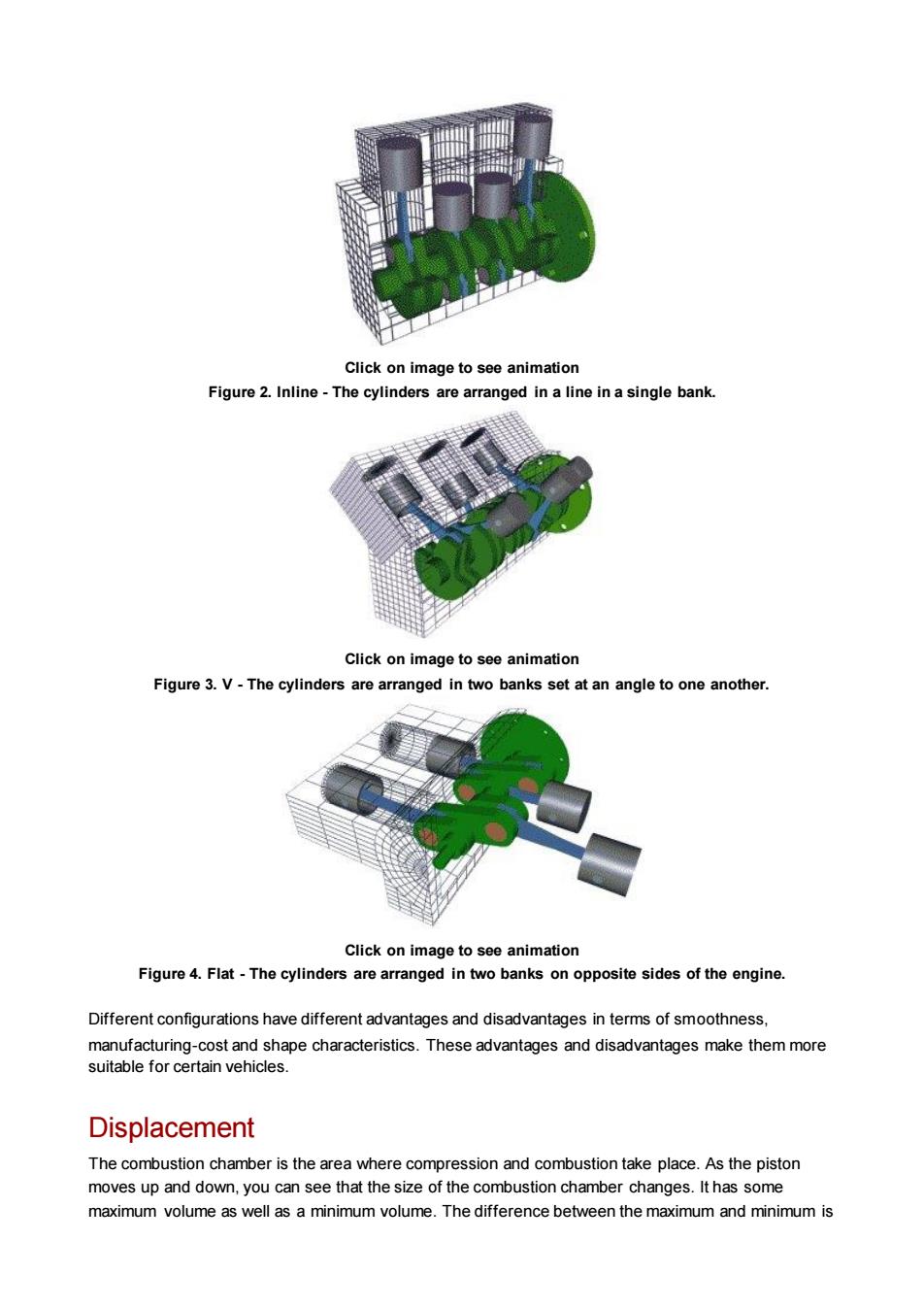
ClickonimagetoseeanimationFigure2. Inline-The cylinders are arranged in a line in a single bank.ClickonimagetoseeanimationFigure 3.V-The cylinders are arranged in twobanks set at an angle to one another.ClickonimagetoseeanimationFigure4.Flat-Thecylindersarearranged intwobanksonoppositesidesoftheengine.Different configurationshavedifferent advantages and disadvantages in terms of smoothness,manufacturing-costandshapecharacteristics.Theseadvantagesanddisadvantagesmakethemmoresuitableforcertainvehicles.DisplacementThecombustionchamberistheareawherecompressionandcombustiontakeplace.Asthepistonmovesupanddown,youcanseethatthesizeofthecombustionchamberchanges.Ithassomemaximumvolumeaswellasaminimumvolume.Thedifferencebetweenthemaximumandminimumis
Click on image to see animation Figure 2. Inline - The cylinders are arranged in a line in a single bank. Click on image to see animation Figure 3. V - The cylinders are arranged in two banks set at an angle to one another. Click on image to see animation Figure 4. Flat - The cylinders are arranged in two banks on opposite sides of the engine. Different configurations have different advantages and disadvantages in terms of smoothness, manufacturing-cost and shape characteristics. These advantages and disadvantages make them more suitable for certain vehicles. Displacement The combustion chamber is the area where compression and combustion take place. As the piston moves up and down, you can see that the size of the combustion chamber changes. It has some maximum volume as well as a minimum volume. The difference between the maximum and minimum is
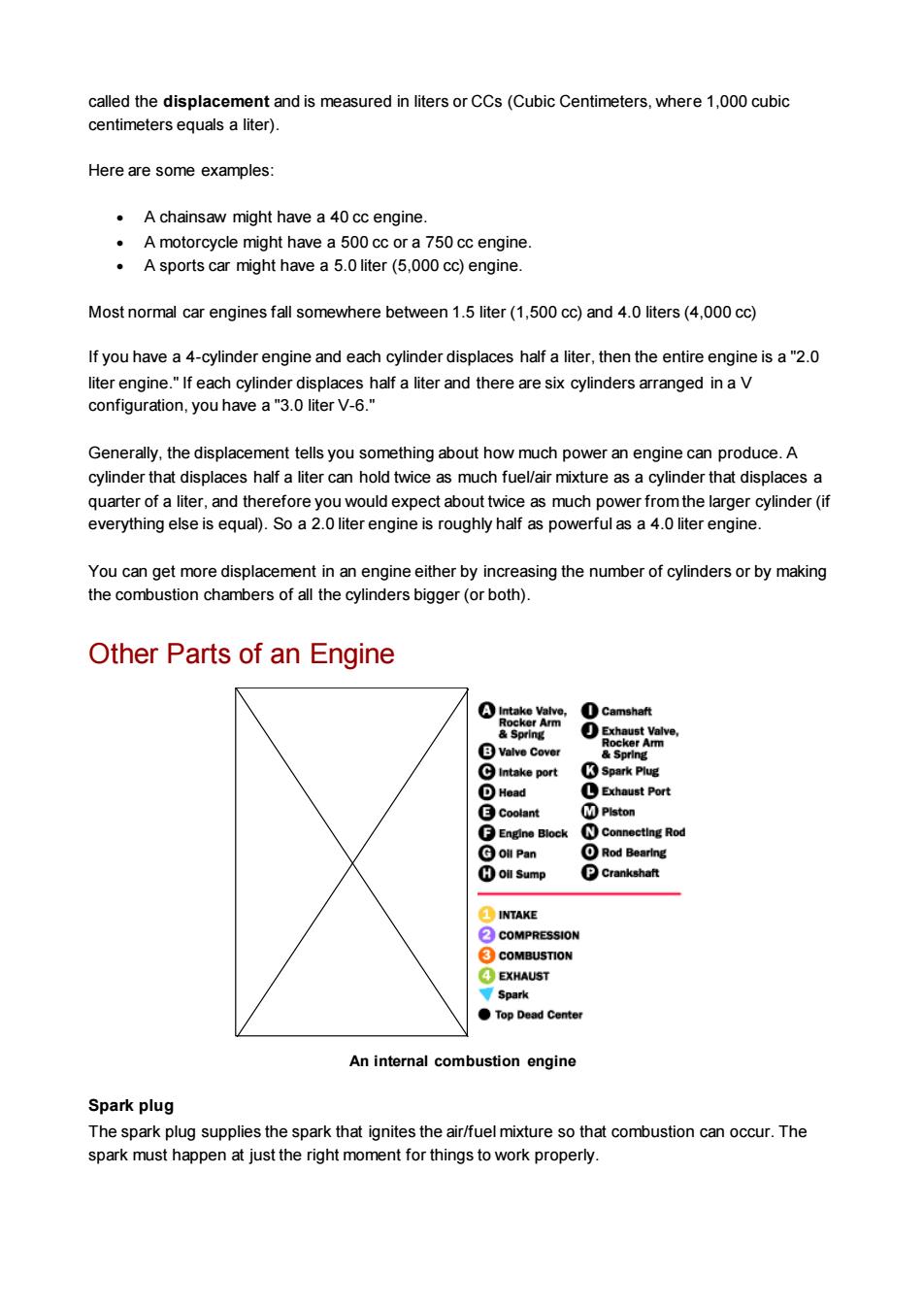
calledthedisplacementandismeasuredin litersorCCs(CubicCentimeters,where1,ooocubiccentimeters equals a liter).Herearesomeexamples:.Achainsawmighthavea40ccengine.Amotorcycle might have a 500 cc or a 750 cc engineA sports car might have a 5.0 liter (5,000 cc) engine.Mostnormalcarenginesfallsomewherebetween1.5liter(1,500cc)and4.0liters(4,000cc)If you have a 4-cylinder engine and each cylinder displaces half a liter, then the entire engine is a"2.0liter engine." If each cylinder displaces half a liter and there are six cylinders arranged in a Vconfiguration,youhavea"3.o literV-6."Generally,the displacement tells you something about howmuch poweran engine can produce.Acylinderthatdisplaceshalfa litercanholdtwiceasmuchfuel/airmixtureasacylinderthat displacesaquarterofa liter,andthereforeyouwouldexpectabouttwiceasmuchpowerfromthelargercylinder(ifeverything else is equal). So a 2.0 liter engine is roughly half as powerful as a 4.0 liter engine.You can get more displacement in an engine either by increasing the number of cylinders or by makingthe combustion chambers of all the cylinders bigger (or both).OtherPartsofanEngineAIntakeValve,OcamshaftRockerArmOExhaust Valve,&SpringRockerAmBValveCover&Spring intake portKSparkPlugDHeadCExhaust PortMPlstonECoolantConnecting RodCEngine BlockORod BearingGoll PanPcrankshaftoil SumpINTAKECOMPRESSION3COMBUSTION4EXHAUSTVSparkTopDead CenterAn internal combustion engineSpark plugThe spark plug supplies the spark that ignites the air/fuelmixture so that combustion can occur.Thespark must happen at just the right moment for things to work properly
called the displacement and is measured in liters or CCs (Cubic Centimeters, where 1,000 cubic centimeters equals a liter). Here are some examples: • A chainsaw might have a 40 cc engine. • A motorcycle might have a 500 cc or a 750 cc engine. • A sports car might have a 5.0 liter (5,000 cc) engine. Most normal car engines fall somewhere between 1.5 liter (1,500 cc) and 4.0 liters (4,000 cc) If you have a 4-cylinder engine and each cylinder displaces half a liter, then the entire engine is a "2.0 liter engine." If each cylinder displaces half a liter and there are six cylinders arranged in a V configuration, you have a "3.0 liter V-6." Generally, the displacement tells you something about how much power an engine can produce. A cylinder that displaces half a liter can hold twice as much fuel/air mixture as a cylinder that displaces a quarter of a liter, and therefore you would expect about twice as much power from the larger cylinder (if everything else is equal). So a 2.0 liter engine is roughly half as powerful as a 4.0 liter engine. You can get more displacement in an engine either by increasing the number of cylinders or by making the combustion chambers of all the cylinders bigger (or both). Other Parts of an Engine An internal combustion engine Spark plug The spark plug supplies the spark that ignites the air/fuel mixture so that combustion can occur. The spark must happen at just the right moment for things to work properly